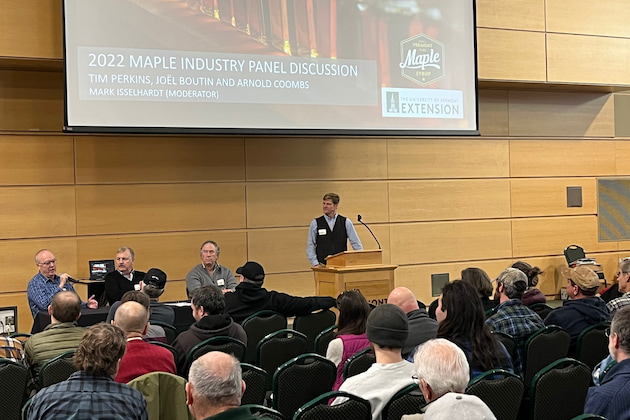Headlines
Maple industry in Vermont thriving
Expert panel is bullish on maple
By PETER GREGG | JANUARY 30, 2023
RANDOLPH, Vt.—The maple industry is mostly thriving but some challenges lie ahead.
That was the message from a panel of industry experts during the VMSMA & UVM Extension winter conference last month.
“I’m always optimistic but it seems we are at a bit of a crossroads,” said Arnold Coombs of Coombs Family Maple and the primary sales agent for Bascom Maple Farms.
Coombs said retail grocery stores are not happy with syrup price increases, as inflation catches up with the industry overall.
On the production side, the trees and sap production are thriving.
“The maple industry is in a really healthy position,” said Dr. Tim Perkins of the UVM Proctor Maple Research Center. “We're doing quite well and learning more and more each year.”
Joel Boutin, a Quebec maple industry consultant to many of the largest sugar bushes in the province concurred.
“As we saw last year, no matter the weather we are always surprised by how much sap can flow,” he said.
The 2022 global syrup crop was the biggest on record in both Quebec and the United States.
Coombs said there was concern in the grocery industry about off flavored syrup hitting the store shelves and turning off consumers.
“There is syrup out there that I have to compete against that is not up to snuff,” he said. “It is low priced and off flavor. That needs to be policed,
There is some syrup I tried during a visit to Australia and it was terrible—the worst I ever had. If a consumer there bought some of that, I dont think they would buy maple ever again. Things like that are not good for the long-term stability of our industry.”
Other challenges include invasive species and climate change, Perkins said.
‘The projections vary tremendously but the conditions for sap flow are going to change,” he said.
He also noted that the Spotted Lanternfly, while not currently affecting Vermont, is something producers should be keeping an eye on.
The panel also considered the maximum output of the trees.
Perkins said there is still more capacity to be achieved.
“Long term, there are other things we can do to go up another 15 to 25 percent,” he said. “We are pretty sure that right now we are able to get to 7.5 pounds per tap pretty consistently.”
Boutin agreed that the industry can still improve production.
“In the future if we all raise our averages that will be huge,” he said.
































